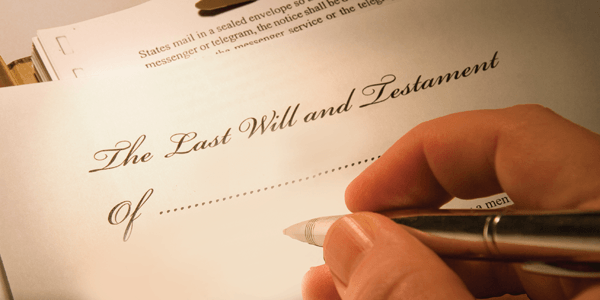Thursday April 25, 2024
Personal Planner

IRA and 401(k) Designated Beneficiary Options
Each year, IRAs and 401(k)s are subject to required minimum distributions (RMDs). Because the distributions start at just under 4% at age 73 and then slowly increase, many IRA and 401(k) plans earn more than those payouts and will continue to grow. While the distributions will become larger as the owner ages, most individuals will eventually pass away with an IRA or 401(k) balance reasonably close to the value of their plan at age 73.
For this reason, the eventual distribution options for an IRA or 401(k) are quite important. For many individuals, the IRA or 401(k) may be the largest asset in their estate.
IRAs and 401(k)s are transferred to a designated beneficiary that is selected on an IRA or 401(k) custodian's form. The five common choices for designated beneficiary are the surviving spouse, children, charity, a trust for children or a trust for spouse and children.
1. Spouse as Beneficiary
The most common choice for a married couple is to select the surviving spouse as the designated beneficiary of an IRA or 401(k). When the IRA or 401(k) owner passes away, the surviving spouse usually chooses to roll the decedent's IRA over into his or her IRA.
Assume that Harry Smith is the IRA owner and he passes away with Helen Smith as his designated beneficiary. Helen is age 68 when Harry passes away and she rolls over the IRA into her plan.
When Helen reaches age 73, she must start taking required minimum distributions. The initial minimum distribution must be taken by April 1 of the next year and is just under 4%. Her distribution will steadily increase as she becomes more senior.
Because Helen rolled over Harry's IRA into her IRA, she qualifies for the lower required minimum distributions under the uniform table. Helen often selects children or charities as designated beneficiaries after she passes away.
If you are in a community property state and plan to leave your IRA to a trust or other beneficiary that is not your spouse, then it is essential to obtain a written consent from your spouse. In many states, attorneys who prepare estate plans will frequently use a waiver if the spouse is not the designated beneficiary of an IRA.
2. Children
For a surviving spouse or single person, an IRA or 401(k) may be transferred to children, nephews, nieces, other heirs or charity. Each child or other heir may take distributions for a period of up to ten years. With the exception of a spouse, a minor child, a child with a disability or chronic illness or an heir who is less than ten years younger than the IRA owner, the full IRA must be distributed within ten years of the death of the IRA owner.
Prior to 2020, a child was able to "stretch" the IRA payout over his or her life expectancy. A 60-year-old child of the IRA owner would have been able to start distributions at age 61 at approximately 4% and stretch those payouts over 26 years. Now, a child or other heir of the IRA owner must usually take all distributions within ten years.
Unfortunately, with many children the ten-year stretch plan will not be successful. CPAs report to the author that approximately one-half of children choose to take the traditional IRA distribution early, even though that means paying the income tax earlier and losing the benefit of the tax-free growth over the maximum distribution period.
3. Charity
For an IRA or 401(k) owner, the qualified plan is a wonderful benefit and a very good asset. However, when the owner passes away, a traditional IRA or 401(k) is often transferred to children with a large "you owe the IRS" tax bill attached (unlike the Roth IRA, which is income tax-free). For the vast majority of qualified plans, the child will pay income tax. Worse yet, the IRA or 401(k) distributions may even push the child into a higher tax bracket.
With income tax on the traditional IRA or 401(k) and no income tax paid on an inherited home, land or stocks, the IRA or 401(k) is a less desirable asset for children. In fact, many children consider this a "bad asset" because of the income tax on most IRA payouts to children.
For this reason, children would prefer to receive a home, land or stock because there is no income tax bill attached. The wise planning decision is to transfer the home, stocks or land (the good assets) to children and save all the IRA income tax by transferring it to charity.
Because charities are tax exempt, there is no payment of income tax or estate tax on a traditional IRA or 401(k). The charity receives the full value tax free. By transferring the IRA or 401(k) to charity, it is possible to turn a bad asset into a good asset.
4. "Give It Twice" Trust
What plan could protect children from spending the IRA amounts and paying maximum income tax? Could a plan combine the tax-saving benefits of a stretch IRA with a term-of-years or life payout to children or other heirs? Could this plan also have the tax-free growth benefit of a stretch IRA?
A wonderful solution is an IRA to testamentary unitrust plan, which includes all of these benefits. A single person or surviving spouse may create an unfunded lifetime unitrust or testamentary unitrust in a will or living trust. The IRA beneficiary designation is to the trustee of that unitrust.
When the IRA owner passes away, the unitrust is funded with the traditional IRA. Because the unitrust is tax-exempt, there is a bypass of the income tax on the traditional IRA and any future growth. The children or other heirs receive new taxable income from the trust investments. The 5% unitrust payouts may last for a term of 20 years or for their lifetimes.
A very good plan for parents who have made lifetime gifts to charity is to combine a benefit to children with a future benefit to charity. This plan is called a "Give It Twice" trust.
For example, Mary Smith had an $800,000 estate. She lived in a home worth $200,000, had a CD for $200,000 and $400,000 in her traditional IRA. Her IRA was substantial because when her husband Bill passed away, she rolled over his IRA into her IRA. The combined IRA is now half of her estate.
Mary has two children and decides to transfer the home and CDs to the children in equal shares when she passes away. They each receive $200,000 in value from the home and CDs with no income or estate tax.
After Mary passes away, the $400,000 IRA is transferred into a charitable remainder trust. It receives the IRA proceeds and invests the full $400,000. The trust pays 5%, which is divided between the two children for a term of 20 years. At the end of 20 years, the trust principal plus growth is given to charity.
Mary was pleased with her plan because she had achieved several goals. First, she provided both principal and income to her children. This is a very good plan because some children will benefit from time to improve their money management skills. Second, she saved income tax on the traditional IRA. Because a unitrust is tax exempt, it receives the entire IRA tax free. The trust earns income for the children for a term of 20 years and is then transferred tax free to charity.
Because the trust benefits the children with more than $400,000 in income and then is given to charity, it truly may be called a "Give It Twice" trust.
5. Trust for Spouse and Children
For individuals with larger estates, it may make good sense to create a trust for surviving spouse and then a term of years for children. After the first person passes away, the IRA is transferred into the trust for the surviving spouse. The trust will distribute income for his or her lifetime and then to children for a term of 20 years. Following the life of the spouse plus 20 years for the children, the trust remainder is distributed to charity.
This trust has several benefits. First, it may save very large income taxes because the trust is tax exempt. Second, the trust can be a "net plus makeup" plan that allows the spouse to choose to save taxes by taking reduced income during life. This will allow the trust principal to continue to grow and build up the trust so there is greater income to children.
This plan is an excellent way to benefit the surviving spouse, children and charity.










